Betelgeuse Continues to Dim, But Why?
A nearby red supergiant star by the name of Betelgeuse has long been popular among astronomers, not only because of its massive size and close proximity to our solar system, but also because of some moderately peculiar luminosity fluctuations as of late that have resulted in an abundance of confusion in the scientific community.
Image Credit: Pixabay
At the start of the year, astronomers reported that Betelgeuse’s brightness had diminished by almost one full magnitude. More recently, however, a paper published in The Astronomer’s Telegram, indicates that the star’s fading hasn’t let up and that its magnitude has already dipped by more than 1.506.
The paper establishes that Betelgeuse’s temperature has fallen by 100 Kelvin since last September and that its luminosity has fallen by 25% in the same timeframe. Likewise, the red supergiant has swelled to become nine percent larger.
Related: Everything we know so far about the purported 'alien megastructure star'
It’s well established in that Betelgeuse is a semi-regular variable star, and this means that its brightness can vary unpredictably over time. On the other hand, recent brightness dips have touched unprecedented levels as if to signal that something significant could be happening. Some have even suggested that Betelgeuse could be nearing the end of its life and that it could be on the verge of going supernova.
Based on what astronomers know about red supergiant stars like Betelgeuse, the aforementioned idea isn’t that far-fetched. The kicker, however, is how models predict that Betelgeuse still has another 10,000 years to live before that happens, give or take a very possible margin of error.
While this is certainly the most substantial dip ever recorded in Betelgeuse’s magnitude, one thing worth noting is that astronomers have observed a slowdown in the star’s rate of fading. It’s a bit of a head-scratcher, but it’s possible that this is a sign that whatever’s happening could be on the verge of normalizing.
Related: Say hello to the largest star ever discovered
The inability to explain Betelgeuse’s eccentric dimming behavior as of late has given rise to alternative theories about its circumstances. Some astronomers say it’s possible that the star’s outer layers are breaking free of its gravitational pull. Consequently, the ensuing cooling gasses would therefore block Betelgeuse’s starlight to make it appear dimmer than it really is.
Sadly, these are all just theories, and Betelgeuse is much too far away for astronomers to reach any definite conclusions. With that in mind, there’s very little that we can do besides sit back and watch as Betelgeuse does what it’s going to do.
Source: Phys.org, The Astronomer's Telegram









